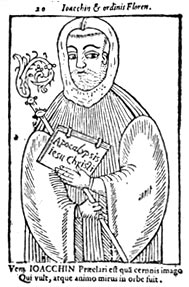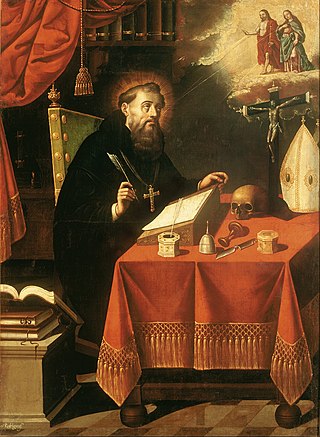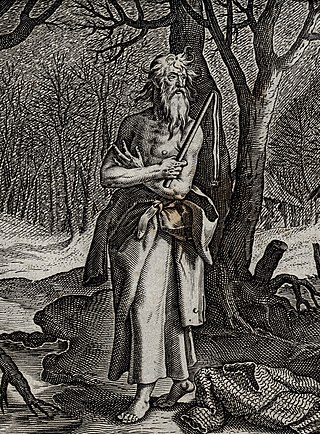Related Research Articles
Christian eschatology is a minor branch of study within Christian theology which deals with the doctrine of the "last things", especially the Second Coming of Christ, or Parousia. The word eschatology derives from two Greek roots meaning "last" (ἔσχατος) and "study" (-λογία) – involves the study of "end things", whether of the end of an individual life, of the end of the age, of the end of the world, or of the nature of the Kingdom of God. Broadly speaking, Christian eschatology focuses on the ultimate destiny of individual souls and of the entire created order, based primarily upon biblical texts within the Old and New Testaments. Christian eschatology looks to study and discuss matters such as death and the afterlife, Heaven and Hell, the Second Coming of Jesus, the resurrection of the dead, the rapture, the tribulation, millennialism, the end of the world, the Last Judgment, and the New Heaven and New Earth in the world to come.
Millennialism or chiliasm is a belief which is held by some religious denominations. According to this belief, a Messianic Age will be established on Earth prior to the Last Judgment and the future permanent state of "eternity".

Montanism, known by its adherents as the New Revelation, was an early Christian movement of the mid-to-late 2nd century, later referred to by the name of its founder, Montanus. Montanism held views about the basic tenets of Christian theology similar to those of the wider Christian Church, but it was labelled a heresy for its belief in new prophetic figures. The prophetic movement called for a reliance on the spontaneity of the Holy Spirit and a more conservative personal ethic.
Millenarianism or millenarism is the belief by a religious, social, or political group or movement in a coming fundamental transformation of society, after which "all things will be changed". Millenarianism exists in various cultures and religions worldwide, with various interpretations of what constitutes a transformation.
The Millerites were the followers of the teachings of William Miller, who in 1831 first shared publicly his belief that the Second Advent of Jesus Christ would occur in roughly the year 1843–1844. Coming during the Second Great Awakening, his teachings were spread widely and grew in popularity, which led to the event known as the Great Disappointment.

Flagellants are practitioners of a form of mortification of the flesh by whipping their skin with various instruments of penance. Many Christian confraternities of penitents have flagellants, who beat themselves, both in the privacy of their dwellings and in public processions, to repent of sins and share in the Passion of Jesus.
In Christian eschatology, postmillennialism, or postmillenarianism, is an interpretation of chapter 20 of the Book of Revelation which sees Christ's second coming as occurring after the "Millennium", a messianic age in which Christian ethics prosper. The term subsumes several similar views of the end times, and it stands in contrast to premillennialism and, to a lesser extent, amillennialism.
Premillennialism, in Christian eschatology, is the belief that Jesus will physically return to the Earth before the Millennium, heralding a literal thousand-year messianic age of peace. Premillennialism is based upon a literal interpretation of Revelation 20 in the New Testament, which describes Jesus's reign in a period of a thousand years.

Hermann von Salza was the fourth Grand Master of the Teutonic Knights, serving from 1210 to 1239. A skilled diplomat with ties to the Frederick II and the Pope, Hermann oversaw the expansion of the military order into Prussia.

Joachim of Fiore, also known as Joachim of Flora, was an Italian Christian theologian, Catholic abbot, and the founder of the monastic order of San Giovanni in Fiore. According to theologian Bernard McGinn, "Joachim of Fiore is the most important apocalyptic thinker of the whole medieval period." The Divine Comedy of Dante Alighieri is one of the most famous works possibly inspired by his ideas. Later followers, inspired by his works in Christian eschatology and historicist theories, are called Joachimites. On June 27, 2024, Pope Francis, in his message for the World Day of Creation, described Joachim of Fiore, saying that "Joachim was able to propose the ideal of a new spirit of coexistence among people" and thus marks a turning point in history, as this had not happened in more than eight centuries since the death of the Florensis monk.

The People's Crusade was the beginning phase of the First Crusade whose objective was to retake the Holy Land, and Jerusalem in particular, from Islamic rule. In 1095, after the head of the Roman Catholic Church Pope Urban II started to urge faithful Christians to undertake an armed pilgrimage to Jerusalem, the People's Crusade was conducted for roughly six months from April to October 1096. It is also known as the Peasants' Crusade, Paupers' Crusade or the Popular Crusade as it was executed by a mainly untrained peasant army prior to the main church-organized crusade. It was led primarily by Peter the Hermit with forces of Walter Sans Avoir. The peasant army of this crusade was destroyed by the forces of the Seljuk Turks under Kilij Arslan at the Battle of Civetot in northwestern Anatolia.

Amillennialism or amillenarism is a chillegoristic eschatological position in Christianity which holds that there will be no millennial reign of the righteous on Earth. This view contrasts with both postmillennial and, especially, with premillennial interpretations of Revelation 20 and various other prophetic and eschatological passages of the Bible.

The term White Lotus Society or White Lotus Teaching refers to a variety of religious and political groups that emerged in China over many centuries. Initially, the name was associated with Pure Land Buddhist organizations that sought to promote devotional practices centered rebirth in a Buddha's Pure Land. These early societies emphasized spiritual salvation through faith, chanting of Amitābha's name (nianfo), and adherence to moral precepts.

Isaac Newton was considered an insightful and erudite theologian by his Protestant contemporaries. He wrote many works that would now be classified as occult studies, and he wrote religious tracts that dealt with the literal interpretation of the Bible. He kept his heretical beliefs private.

Dominic Loricatus, O.S.B. Cam., was an Italian monk, born in the village of Luceolis near Cantiano. His father, seeking social advancement, paid a bribe to have him ordained a priest when still a child. When he discovered the fact, he resolved on a life of penance and became a hermit in the woods near the abbey of S. Emiliano in Congiuntoli, then a Camaldolese monk at the monastery of Fonte Avellana in 1040.
The Pursuit of the Millennium: Revolutionary Millenarians and Mystical Anarchists of the Middle Ages is Norman Cohn's study of millenarian cult movements.

Walkenried Abbey was a Cistercian abbey located in the village of Walkenried in Lower Saxony, Germany. Founded in 1127 on the southern rim of the Harz mountain range, the remnants of the monastic complex since 2010 are part of the Upper Harz Water Regale World Heritage Site.

The Ahmadiyya branch in Islam has relationships with a number of other religions. Ahmadiyya consider themselves to be Muslim, but are not regarded as Muslim by mainstream Islam. Mainstream Muslim branches refer to the Ahmadiyya branch by the religious slur Qadiani, and to their beliefs as Qadianism a name based on Qadian, the small town in India's Punjab region where the founder of Ahmadiyya, Mirza Ghulam Ahmad was born.
Robert of Avesbury was an English historian.
The German Inquisition was established by Pope Gregory IX in 1231, and the first inquisitor was appointed in the territory of Germany. In the second half of the 14th century, permanent structures of the Inquisition were organized in Germany, which, with the exception of one tribunal, survived only until the time of the Reformation in the first half of the 16th century. In combating heretics in Germany, the Inquisition always played a secondary role compared to the ecclesiastical courts.
References
- 1 2 3 4 Herman Haupt (1890), "Schmid, Konrad", Allgemeine Deutsche Biographie (in German), vol. 31, Leipzig: Duncker & Humblot, p. 683
- 1 2 Kneale, Matthew (2013). An Atheist's History of Belief: Understanding Our Most Extraordinary Invention. Random House. p. 94. ISBN 978-1448163311 . Retrieved 12 June 2018.
- ↑ Toke, Leslie A. St. L. (Leslie Alexander St. Lawrence) (1913). . In Herbermann, Charles (ed.). Catholic Encyclopedia . New York: Robert Appleton Company.
- ↑ Cohn, Norman (1970). The Pursuit of the Millennium: Revolutionary Millenarians and Mystical Anarchists of the Middle Ages (Revised and enlarged ed.). Oxford University Press. p. 142. ISBN 0198020023 . Retrieved 12 June 2018.
- ↑ Cohn, pp. 142–3
- ↑ Wainwright, Arthur W. (2001). Mysterious Apocalypse: Interpreting the Book of Revelation. Wipf and Stock. p. 89. ISBN 1579106242 . Retrieved 12 June 2018.
- ↑ Kneale (2013), pp. 94–5
- 1 2 3 Cohn (1970), p. 167
- 1 2 Cohn (1970), pp. 145–6
- ↑ Cohn (1970), pp. 146–7